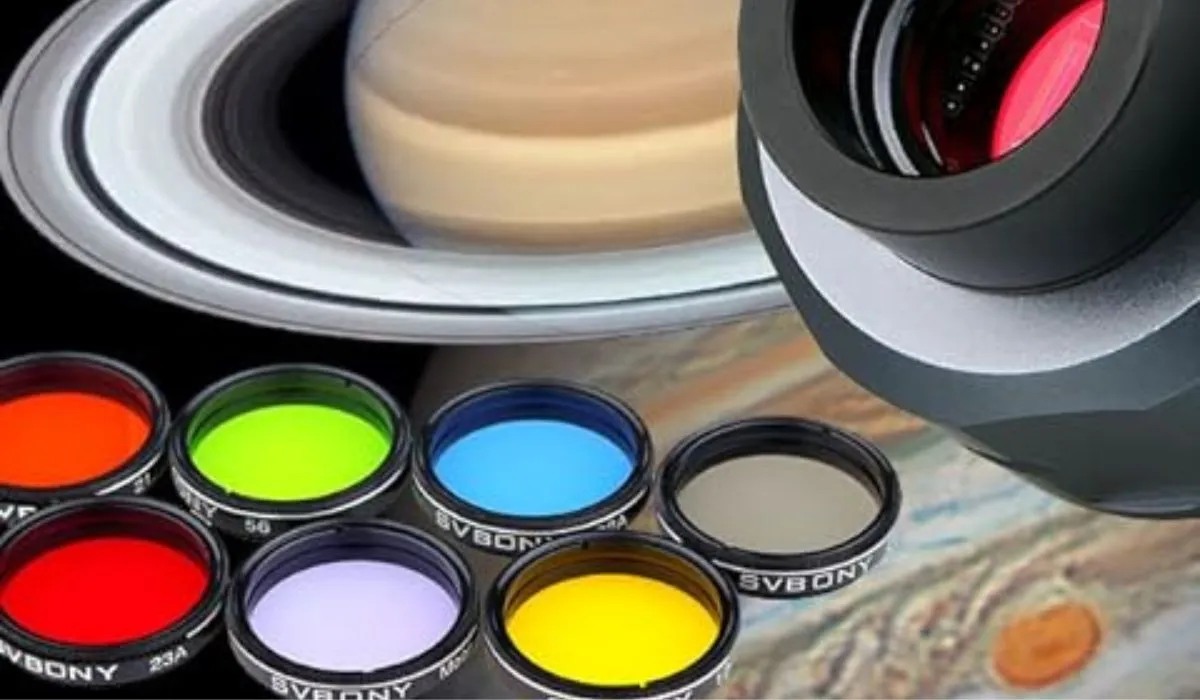Through them, we have been able to catch a glimpse of faraway nebulae, galaxies, and other heavenly bodies. However, to properly enjoy the splendor of the universe, astronomers often rely on filters that intensify specific wavelengths of light. In this exploration of the cosmos, let’s learn more about the sorts of telescope filters, their uses, and the mysteries they reveal.
Types of Filters
There is a wide variety of telescope filters available, each optimized to filter out a certain range of the electromagnetic spectrum and reveal hidden details in distant galaxies. List some typical examples:
Broadband Filters: Peering into the Cosmic Rainbow
Broadband filters, often known as color filters, are analogous to the ordinary photographic filters. They filter off unwanted wavelengths of light, making astronomical details more obvious. For instance, a red filter can bring out the textures on the surface of Mars, while a blue filter might highlight the ice features of Jupiter’s moons.
Narrowband Filters: Cutting Through the Light Pollution
Light pollution is a problem for stargazers in cities. To rescue us, narrowband filters isolate individual gaseous emission lines like hydrogen alpha and oxygen III. Astronomers are able to get far clearer photographs of nebulae and other deep-sky phenomena with the use of these filters because they successfully cut through light pollution.
Solar Filters: Safely Observing Our Star
Using a telescope to look at the sun directly is dangerous for your eyes and telescope. Solar filters, sometimes composed of specific materials like Mylar or Baader AstroSolar film, allow astronomers to safely study the sun. They filter off potentially dangerous wavelengths while allowing others to pass through, allowing phenomena like sunspots and solar flares to be seen.
Neutral Density Filters: Taming the Celestial Brightness
The moon and bright planets, in particular, can be blindingly brilliant when viewed through a telescope. When attached to a telescope, neutral density filters act like sunglasses, blocking off some of the light so that more of the object’s intricate structure may be seen.
The Magic of Broadband Filters
Amateur astronomers rely heavily on broadband filters since they are a cheap and easy approach to improve their observations. Let’s have a look at a few important uses:
Lunar Observations: Unveiling Craters and Mountains
Using a colored filter to look at the moon can help you see some features more clearly. By using a blue filter, for example, the craters and mountains on the Moon become more clearly defined. On the other hand, a red filter might be employed to lessen the glare and highlight surface features on the moon.
Jupiter’s Atmosphere Exploration and Detailing
Jupiter, with its beautiful cloud formations, is a favored subject for many astronomers. Scientists can learn more about the make-up and movement of Jupiter’s atmosphere by using colored filters. Using a red filter, for instance, the Great Red Spot and other cloud bands can stand out, while using a blue filter may bring out the cold clouds that encircle the planet.
Planetary Exploration: Detailing Jupiter’s Atmosphere
Light pollution, caused by an increase in cities, diminishes the visibility of the night sky. Astronomers can see through the light pollution by focusing on specific wavelengths of light with the use of narrowband filters. Examples of popular narrowband filters are:
Narrowband Filters and the Fight Against Light Pollution
The hydrogen-alpha wavelength is emitted by nebulae, which are enormous clouds of gas and dust. Hα filters isolate this unique light, illuminating the complex intricacies of nebulae like the Orion Nebula or the Lagoon Nebula. These filters are be especially handy in urban areas, where the bright lights of buildings can obscure even the faintest of celestial objects.
Hydrogen-Alpha (Hα) Filters: Revealing Nebulae in Red Splendor
To bring out the ethereal light of planetary nebulae and supernova remnants, astronomers use filters that isolate the doubly ionized oxygen molecule, or OIII. An OIII filter can be a game-changer for astronomers attempting to take magnificent photos of celestial objects in regions with high levels of light pollution.
Oxygen-III (OIII) Filters: Capturing the Ghostly Glow
The sun is a dynamic, ever-changing celestial body and the closest star to Earth. Special solar filters must be used when looking at the sun via a telescope to prevent damage to the eye and the telescope.
Solar Filters: Gazing at the Sun Safely
The sun is a dynamic, ever-changing celestial body and the closest star to Earth. Special solar filters must be used when looking at the sun via a telescope to prevent damage to the eye and the telescope.
White Light Solar Filters: A Glimpse into Sunspots
To better detect sunspots, which are transitory phenomena caused by intense magnetic activity, white light solar filters are employed to diminish the sun’s overall brightness. These filters are needed for safe solar observation and research.
Hydrogen-Alpha (Hα) Solar Filters: Dancing Prominences and Filaments
Solar prominences and filaments can be seen with the use of H solar filters, which are designed to filter out just the light of a specific wavelength released by hydrogen-alpha. The continual activity of the sun’s atmosphere is beautifully revealed by these filters.
Neutral Density Filters: Taming Celestial Brilliance
The moon’s reflective surface makes it a difficult target for telescopes. With the help of neutral density filters, astronomers are able to examine the lunar surface’s features in greater detail by reducing the overall brightness. These filters are especially helpful for viewing bright planets like Venus and Jupiter without straining your eyes and without losing any of the finer features.
Conclusion
Selectively filtering light, telescope filters are the unsung heroes of celestial observation. Each type of filter is essential in bringing out the hidden beauty of the universe, from the vivid colors of planetary atmospheres to the wispy tendrils of faraway nebulae. Whether you’re a seasoned astronomer or a newbie gazing at the night sky for the first time, the world of telescope filters invites you to embark on a journey of discovery and amazement, expanding your cosmic horizons one filter at a time.
Also Read: Exploring the Cosmos: Telescopes to Witness Planetary Wonders.
Frequently Ask Questions (FAQs)
What are Telescope Filters, and Why are They Used?
Filters for telescopes are optical components that selectively let through or block off certain frequencies of light. They help astronomers improve their observations by separating objects, decreasing glare, and blocking out unwanted light.
How Do Broadband Filters Differ from Narrowband Filters?
Broadband filters, often known as color filters, remove or reduce a spectrum of colors in order to emphasize a given trait. Narrowband filters, on the other hand, zero in on narrow bands of the spectrum, isolating specific emission lines from background light.
Can Telescope Filters be Used for Daytime Observations?
Yes, neutral density filters and other types of telescope filters can be used for daytime observations. It is possible to study the sun, planets, and other bright celestial objects with the use of these filters because of their ability to diffuse light.
Are Telescope Filters Necessary for Lunar Observations?
Telescope filters, especially color filters, can greatly improve lunar viewing, but they are not required. By adjusting the brightness and contrast, craters and mountain ranges on the Moon are brought into sharp focus.
Exactly how can solar filters protect observers from harmful radiation?
White light and hydrogen-alpha filters are two types of solar filters used for protecting humans and electronics during solar observations. They lessen the intensity of the sun’s rays, making it possible to safely study solar phenomena including sunspots, flares, and prominences.











